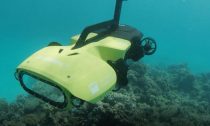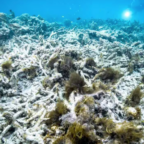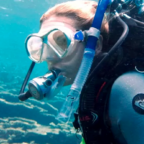
Crown-of-thorns starfish are having a devastating impact on the health of the Great Barrier Reef but a robot drone is set to track and kill them. RangerBot is a hunting machine that uses a hi-tech vision system to track and kill crown-of-thorns starfish (COTS), as well as monitoring reef health indicators like coral bleaching and water quality. The machine has been developed over the past ten years by roboticist Matthew Dunbabin in collaboration with Queensland University of Technology, Google and the Great Barrier Reef Foundation.
The deadly starfish pose a huge threat to the coral in the Great Barrier Reef. According to a report, published in the journal Nature, COTS outbreaks have a higher impact on reef health than coral bleaching and disease combined. The starfish, which has barbs that are poisonous to humans, is native to the reef but can reach plague conditions when phytoplankton (their food source) increases from floods, washing fertilisers and other pollution from land into the sea. In 2015, the World Wide Fund for Nature reported that, in the past 30 years, the reef had lost half its coral cover and 40% of that loss was due to COTS.
Currently, divers have to inject ten to 12 millilitres of ox bile into each starfish in order to kill them but the RangerBot is set to get the job done more efficiently. It can stay underwater almost three times longer than divers, collect more data and operate in all conditions during night and day. Its tanks carry enough poison to kill more than 200 starfish in one four- to eight-hour mission. In addition, it can reach parts of the sea that may be dangerous for human divers.
“RangerBot is the world’s first underwater robotic system designed specifically for coral reef environments, using only robot-vision for real-time navigation, obstacle avoidance and complex science missions,” Professor Dunbabin said. “This multifunction ocean drone can monitor a wide range of issues facing coral reefs including coral bleaching, water quality, pest species, pollution and siltation. It can help to map expansive underwater areas at scales not previously possible, making it a valuable tool for reef research and management.”
The machine has been ‘trained’ to detect COTS and can identify the deadly starfish with a 99.4% accuracy. Once the RangerBot identifies its prey, it instigates an injection of ox bile which is fatal for COTS but doesn’t harm anything else on the reef.
RangerBot was launched last Thursday in Townsville, North Queensland and Dunbabin said the team hoped to eventually launch the drones up the length of the 2300-kilometre-long reef. The 15kg machine is pretty compact and can be operated from a smart tablet. The team also plans to make the robot available for reef management teams around the globe.
“More than a billion people depend on coral reefs for their food and livelihood – they stand to lose the most if those important ecosystems are not protected,” Dunbabin said. “Our vision is to make RangerBots readily available and accessible to be deployed on the reef where they’re most needed and to put them in the hands of reef managers, researchers and communities worldwide.”














Social Profiles